Articles | The Death and Rebirth of the Cosmic Christ
Writen by Igor Oakwood 20/12/2021
9024 views0 comments
All classical ancient civilizations had their own
cosmologies, based on naked-eye observations of the sky. Some of these civilizations have done during thousands of years and have kept the cyclic movements of the stars with an accuracy which still baffles us today. Comparing the different cosmologies of these classical civilizations reveals a common thread which leads to a common
mother cosmologythat dates back to Paleolithic times. The common thread in the story is a universal archetype represented in the oldest archaeological artifacts and mythologies found all over the world: The Cosmic Christ(os).
The Axis Mundi
The concept of a central axis around which the whole cosmos revolves is central in our understanding of Space and Time. Logically we find the Axis Mundi in all ancient cosmologies around the world. The most obvious representation of the axis mundi is the rotational axis of the Earth itself. It is rotation which makes the Sun arching the heaven during the day and the stars and planets during the night. rotational axis points to the pole star, which means that all other stars revolve around it in a seemingly eternal cycle. The pole star is the only one that doesn’t seem to move from its place and was therefore seen as the highest divinity. The most universal representation of axis was a fire drill flanked at its bottom by two guardians who are driving the stick. On top of the fire drill sat the One God who presided over the whole cosmos. The Aztecs called him Tezcatlipoca, for the Maya was Hurakan, in India they called him Prince Dhruvi, for the Celts was the World Tree presided over by the Dagda, the Nordics called it Yggdrasil and in Egypt it was Horus and Seth who made the Fire Drill turn.
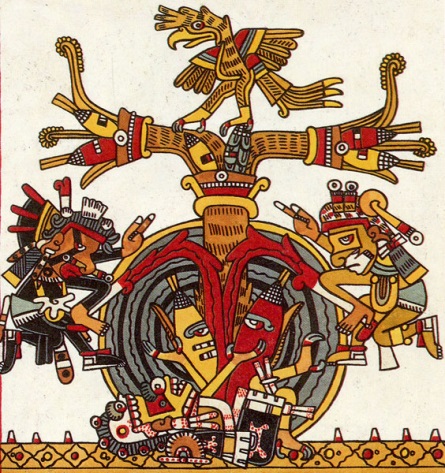
The Fire Drill or World Tree is the primeval machine that creates time. Its turning creates heat and makes life possible. However, it can wear out and it is subject to defects. causes the Earth’s rotational axis to wobble and is responsible for the precession of the equinoxes, a cycle of around 26.000 years. wobble causes the top of the Earth’s axis to point to different stars around circle, with each of them claiming its pole star position again after 26.000 years. The symbol for the Axis Mundi is extremely ancient and appears worldwide. In Hindu-cosmology, is called the Churning of the Ocean of Milk (Milky Way). The polar axis stretching out from the pole star to the Earth’s core manifests in easily recognizable mythical symbols. Logically, in the most ancient cultures that go back to Paleolithic times, the pole star occupied the most important position in the sky. Dr. Michael Rappenglück of Munich University is convinced that the paintings in the Lascaux cave in the Dordogne region in France revealed some very interesting astronomical information. Its main focus was on the paintings in the Well Shaft, where an image can be seen of ‘bird-man’ accompanied by a bison and a bird on top of a pole. According to Rappenglück image was an abstract representation of the stars Deneb (Cygnus), Vega (Lyra) and Altair (Eagle), today called the Summer Triangle. Andrew Collins, author of the groundbreaking book ‘The Cygnus Mystery’ was remembered to the many swan-totems and swan-topped sky poles seen in shamanic art everywhere on the Eurasian continent and which undoubtedly pointed to the epoch that the stars of Cygnus occupied the position of pole star around 16.000 BC.
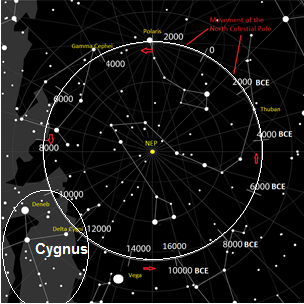
The supposed creation date of the Lascaux painting (14.500 BC) make us therefore conclude that it represents the ‘fall’ of (Deneb) Cygnus from its pole star position. However, there was something more interesting about the pole position of Cygnus around that epoch. The Milky Way, seen as the Mother of Life itself makes a fork or rift right next to the central bulb of our Galaxy. Dark Rift was considered as the Womb of Creation where the souls of the deceased needed to go after death in order to be reincarnated.
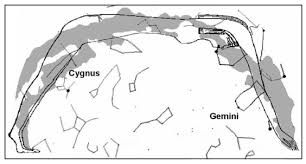
In other words, the stars of Cygnus represented the ‘Portal’ to the Afterlife. Portal (Cygnus constellation) never moves from position in the Milky Way but its coincidence with the pole star position occurs only once in 26.000 years. rare astronomical coincidence of both cosmic centers must have meant a time of ‘umbilical connection’ to the Galactic Mother’s Womb for our Paleolithic ancestors.
The Cosmic Parasol and the Swan
When we have a turning axis, there is all the rest of the sky that turns around it. As I mentioned in the introduction, it is the same cosmic parasol that makes the Sun turn around the Earth in the day lit sky and the stars and planets at night. The stars which lay closest to the pole star are therefore called ‘circumpolar stars’. We know that the Earth’s rotational axis makes a wobble, causing the pole position in the sky to make a circle of 26.000 years (a movement of 1° each 72 years). means that different constellations or stars will occupy the position of pole star during cycle. Among these constellations, there is Cygnus, the heavenly Swan. However, once the Swan was removed from its pole position around 14.500 BC, it became a circumpolar constellation. constellation, most important in the paleolithic mindset because it represents the Portal to the Galactic Womb, was the only reminder of the sacred alignment of the two cosmic centers (pole star and galactic womb). From then on, all through the Neolithic period, the heavenly Swan was seen as moving the circumpolar wheel of constellations around the pole star until it will reclaim its sacred position again around 10.500 AD. As I said before, it is same wheel which moves the Sun around the sky during the day. Therefore, I believe that so-called solar symbols like the Swastikas and crossed wheels found in Neolithic sites all around Eurasia, like the bronze swan-wheel found in the Han-Caves in Belgium for example, are more than mere solar symbols. In fact, they represent the Axis Mundi and the Cosmic Parasol, driven by the Swan and thus the Galactic Mother’s umbilical cord.
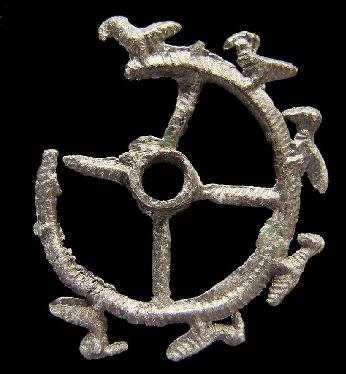
The lead wheel depicted above (unearthed in the Han-Cave, Belgium) with the 8 swans on its circumference clearly symbolizes the Celtic year wheel with the 8 seasonal festivals: 2 equinoxes, 2 solstices and the 4 dates in between.
The Death and Rebirth of Christ
Now, there is one other particularity in the Cygnus Constellation, formerly known as the Northern Cross, which points directly to a link with Christianity. The main stars of Cygnus, sitting at the beginning of the Dark Rift or Galactic ‘Womb’, form a Calvary Cross:
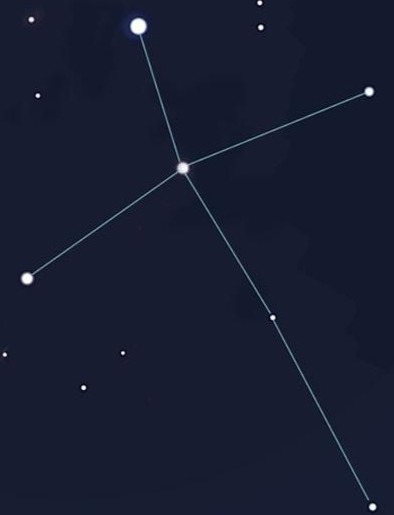
Coïncidence? I don’t think so.
In the northern hemisphere, the Cygnus constellation is best visible during summer, when the northern pole star is at its highest point in the sky. Then the celestial swan occupies the zenit position during most of the night together with two other bright stars: Vega (Lyra) and Altair (Eagle) forming the Summer Triangle. In winter time, obviously, she is less visible because the pole star is at its lowest point in the sky and Cygnus as a circumpolar constellation is under the horizon for most of the night. At winter solstice, she sets at the NW horizon around 10 am and disappears almost entirely under the horizon until she reappears again a few hours before sunrise the next day. In other words, Cygnus heralds the rebirth of the Sun at the solsticial turning point in its annual cycle, like She is pulling the wheel of circumpolar stars. In the Christian liturgical calendar, moment is known as the Death and Rebirth of Christ from his mother, the Holy Virgin. The Holy Virgin from which the Christ is born, obviously, must then be the Milky Way.
Now, we can ask ourselves why then, Christmas, the Birth of Christ, is celebrated only on the 25th December, 3 days after the actual solstice. of course, has to do with the fact that, after solstice, the Sun rises at the same moment during the next three days. It is only from the 25th December that the Sun starts rising earlier and that the days become slowly longer again. makes it seem like the Sun is stagnating for three days after its solsticial point before actually being reborn again. In Christian symbolism, is symbolized by the three days between Jesus’ death on the cross and his resurrection. Now that we are celebrating the annual winter solstice, the above information reveals a bigger, although more rational, no less spiritual truth about the Death and Resurrection of the Cosmic Christ.
Merry Christmas!
